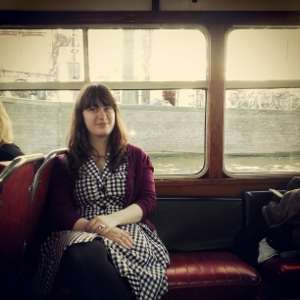The Amsterdam Sinfonietta is an ensemble that is comfortable with both old and new repertoire, and often performes contemporary music. The concert I saw was right in the middle of a tour with violinist Sergey Khachatryan featuring Vivaldi’s Four Seasons and Tchaikovksy’s Souvenir de Florence, but at the Muziekgebouw the program was different; instead of Vivaldi we were treated to Prokofiev’s Vision Fugitives (arranged by Rudolf Barshai) and the world première of Arthur Aharonian’s Violin Concerto No. 2 with star violinist Sergey Khachatryan.
Sergei Prokofiev’s Visions Fugitives was originally a suite for piano, but Rudolf Barshai (famous for his orchestrations of Shostakovich’s string quartets) turned them into beautiful pieces for chamber orchestra. In the introductory talk by cellist Michiel Weidner we learnt that the orchestration is in fact quite ingenious: the original Visions Fugitives have a lot of subtle elements to it that Barshai managed to enlarge while still doing the works justice. The Visions Fugitives were a charming and enticing way to open tonight’s program.
Arthur Aharonian was unknown to me before this concert; he is an Armenian composer living in Paris, and it was solo violinist Sergey Khachatryan that suggested him to the Amsterdam Sinfonietta. Aharonian’s Violin Concerto No. 2 was written especially for Khachatryan and the Amsterdam Sinfonietta, for violin, strings and percussion. The concerto would comfortably fit into the repertoire of 20th-century Russian violin concertos (particularly those of Shostakovich and Prokofiev), as it has a very similar feel. It just so happens that that is exactly the kind of music I love and judging by the crowd’s enthusiastic reaction I was not the only one. The work is played without breaks, and allowed Khachatryan to show off his prodigious skill. I find Khachatryan one of the best solo violinists playing at the moment – his playing quite easily moves me to tears and any composer would be lucky to have him as solo violinist. But again, I do not want to take anything away from the violin concerto. It was turbulent and yet contained some incredibly beautiful cadenzas for the violin. In particular the first cadenza took my breath away – it was melodically powerful and still understated. This cadenza was one of the few calm moments in the music, the energy and pace were kept at a high level throughout the piece, with all the different parts weaving through each other, with tension and just a hint of discomfort that made the piece all the more interesting. I hope that it will at least be recorded by Khachatryan and the Amsterdam Sinfonietta because it does deserve much more than one listen and one performance.
One of the first things you notice when you go to a concert by the Amsterdam Sinfonietta is that they play standing up (apart from the cellos). This seems to really enhance their playing – they are incredibly dynamic and energetic and all the musicians are quite obviously deeply involved with the music. The Aharonian and Tchaikovksy pieces especially benefited from this approach – under the leadship of concertmaster Candida Thompson (there was no conductor), both these pieces became more lively, although it made me wish that I, as an audience member, could be standing up as well and move along with the orchestra.
Tchaikovksy’s piece Souvenir de Florence will be surprising if you are used to the Tchaikovksy of the piano concerto and symphonies. It is much lighter, more Italian. Tchaikovksy loved Italy and the country inspired quite a few of his pieces, including the Capriccio Italien, and he in fact started writing Souvenir de Florence while he was in Florence. It was originally written for string sextet, but the Amsterdam Sinfonietta performed it in double that size. The work is chock-full of melodies that linger in your head, particularly the last movement, and the pleasure the Amsterdam Sinfonietta had while playing it was tangible and lifted everything to a higher level.
Unfortunately the Amsterdam Sinfonietta is one of the ensembles most affected by the arts cuts in the Netherlands, and they will soon lose 30% of their income. After performances like these you cannot help but wonder how such decisions are justified – the Amsterdam Sinfonietta bring something unique to the stage that would be sorely missed.


